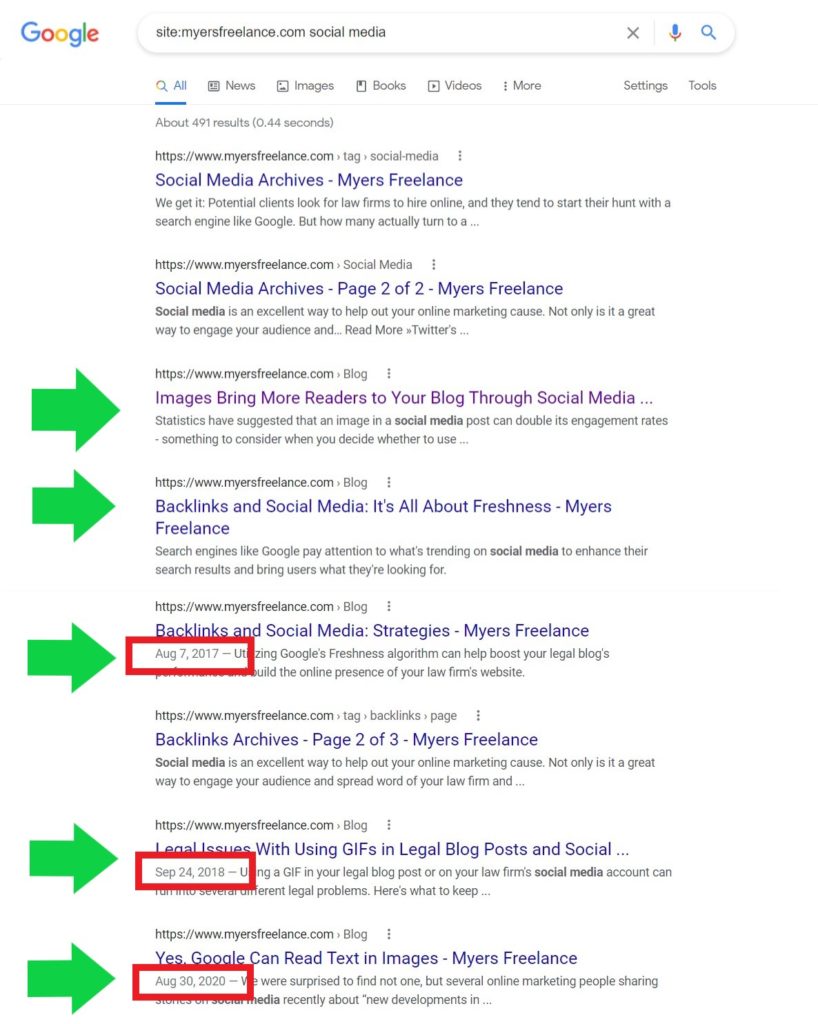Several months ago, we noticed something jaw dropping. Some of our blog articles (green arrows) were appearing in the search engine results page (SERP) without their publication dates (red boxes):

It was stunning (to us). Here’s why.
Remember: Google Wants to Provide Relevant and Important Results
To fully explain, we have to go back to Google’s business model: Bringing relevant and important results to every given search query. When that search query implies an interest in recent or timely information, Google will weigh the freshness of an article in its algorithms. Older articles will cede ground to newer articles on the same topic.
That factor requires the search engine’s awareness of when a given article was published and makes it useful to conspicuously present that publication date so internet users can readily see if an article is stale, or not.
That’s why the search query “covid case count” has (beneath all of the SERP features and graphs at the top) lots of articles that say when they first went live. No one wants to know what the numbers from months ago – they want the stats from today.
The Problems With Putting Datelines in the SERP Listings
Unfortunately, splashing the dateline in the SERP listing is not a one-size-fits-all answer. Not all search queries are looking for recent information – plenty of search queries are looking for information that does not change over time.
This meant that Google’s attempts at providing fresh content and telling users when a particular webpage was published had just opened a can of worms. In plenty of cases, the date of publication was not an indication of quality.
The way that Google handled the problem was vague, at best. It told website owners that it was displaying the publication date of an article when its algorithms suggested that it was worthwhile information to present. But that only begged the question: When did its algorithms suggest…?
Online marketing professionals found that a big factor was whether the page used a datePublished schema. If it did, that date was often displayed in the search. If it didn’t, the SERP listing did not show the date of publication.
Blogs Tended to Have Datelines
What this meant was that blog posts tended to have datelines attached to them in the SERP, while targeted pages and landing pages did not.
That’s why we were stunned to find that around a fifth of our blog posts no longer had datelines on them in the results page. The dateline used to be ubiquitous for our content, regardless of whether it was evergreen or topical.
So what does this mean?
We took a closer look at which of our blog posts still had the dateline, and which did not.
Google Is Trying to Be More Holistic, to Mixed Results
What we found was a bit of a mess. Below is a table of the top 20 hits, our opinion on whether the content needs to be fresh or not (i.e., whether it’s topical or evergreen) and whether Google left the dateline on the SERP result. In theory, if Google was good at gauging the timeliness of online content, the last two columns would consistently match:
| Blog Title | Does It Need to Be Fresh? | Dateline in SERP? |
|---|---|---|
| Backlinks and Social Media: It’s All About Freshness | An ironic probably | No |
| Backlinks and Social Media: Strategies | No | Yes |
| Google’s Freshness Update Gets Applied to Featured Snippets | Yes | Yes |
| Where’d Our Blog Go? | Yes | Yes |
| Evergreen Legal Blog Posts are Dying | A soft yes | No |
| The Q&A Format for Legal Blog Articles | No | Yes |
| Lessons from the Trump Googlebomb | Yes | Yes |
| What is the Role of the Legal Blog in Online Marketing Today? | Probably | No |
| All the Different Legal Marketing Job Titles Explained | No | Yes |
| Images Bring More Readers to Your Blog Through Social Media | No | No |
| Legal Issues With Using GIFs in Legal Blog Posts and Social Media | No | Yes |
| Google Can Read Text in Images | Yes | Yes |
| Escaping the Terrible Cycle of Web Traffic and Rankings | No | Yes |
| Hyper Local SEO is Another Red Herring for Law Firms | Not really | Yes |
| 8 Places to Find a Legal Blog Image and 3 Places to Avoid | No | Yes |
| Twitter Gaffes and What We Can Learn from Them | No | Yes |
| How to Write Yourself Into a Great Blog Image | No | Yes |
| 2 Possible Themes from Google’s December Algorithm Update | Yes | Yes |
| How to Leapfrog Competition By Scoring a Featured Snippet | No | Yes |
| Google Says Author Bylines Are Not an SEO Signal | Yes | Yes |
That’s a lot of swings and misses by the search engine. It took down the datelines from some articles that could be considered evergreen, but not from the articles that most definitely were.
What This Means for Your Legal Blog
Anyone publishing a legal blog should be more proactive and controlling in whether their articles’ publication dates appear in the SERP or not. If your article is evergreen, then you don’t want it to be so conspicuously dated. If it’s topical, then the date is fine. Yes, you’ll lose viewers as time goes by, but that’s what happens when you write about newsy issues.
